Backward Integration
It enhance a company's control over its supply chain and reduce dependency on external suppliers.
Backward Integration is a business strategy that involves a company expanding its operations upstream in the supply chain by acquiring or integrating with suppliers or producers. It is the process of a firm incorporating activities that its suppliers or third-party manufacturers previously carried out.

By implementing it, companies aim to gain control over the production or distribution of key inputs or components used in their final products, ensuring a seamless and efficient supply chain.
The primary objective of Backward Integration is to enhance a company's control over its supply chain and reduce dependency on external suppliers.
By bringing previously outsourced functions in-house, companies can better oversee and manage critical processes, including quality control, cost efficiency, and timely delivery.
This strategic move enables firms to directly influence the production process and eliminate uncertainties associated with supplier reliability and performance.
One of the main advantages of this strategy is increased cost savings. By eliminating the middlemen and directly producing essential components or raw materials, companies can potentially lower production costs, eliminate markups, and have better control over pricing.

It requires significant investments in facilities, equipment, and expertise to undertake the additional production activities successfully.
Furthermore, companies must thoroughly evaluate the potential effects on their core competencies and assess the long-term sustainability of implementing this strategy.
A notable example of successful this strategy is seen in the automotive industry. Several automobile manufacturers have integrated backward to establish production facilities for essential components such as engines, transmissions, or electronic systems.

By integrating backward, companies gain enhanced control over the quality and availability of crucial components, thereby reducing their dependence on external suppliers and minimizing the potential for disruptions in the supply chain.
It is a strategic approach where companies expand their operations upstream in the supply chain by bringing previously outsourced activities in-house. This strategy offers advantages such as increased control, cost savings, and differentiation.
However, it also involves careful evaluation of risks and investments. Companies must weigh the benefits and challenges before implementing this strategy to ensure they align with their long-term goals and enhance their competitiveness.
Key Takeaways
- Backward integration offers advantages such as supply chain control, cost savings, quality assurance, flexibility, customization, competitive advantage, and vertical integration benefits.
- Challenges and risks include capital investment, operational complexity, supplier relationship management, technology and expertise, flexibility and adaptability, and supply chain disruptions.
- Factors to consider for successful backward integration include strategic alignment, feasibility assessment, supply chain analysis, capability assessment, risk management, change management, and continuous evaluation.
- Best practices include a thorough evaluation, strategic alignment, collaborative approach, supplier relationship management, technology and expertise, continuous monitoring and evaluation, flexibility, and adaptability.
- Open and transparent communication with stakeholders is essential for successful backward integration. Engage and involve employees, suppliers, and customers to build support and address concerns.
Advantages Of Backward Integration
Backward integration, as a strategic business approach, offers several advantages to companies that choose to implement it. By expanding their operations upstream in the supply chain, organizations can achieve greater control, cost savings, and strategic positioning.
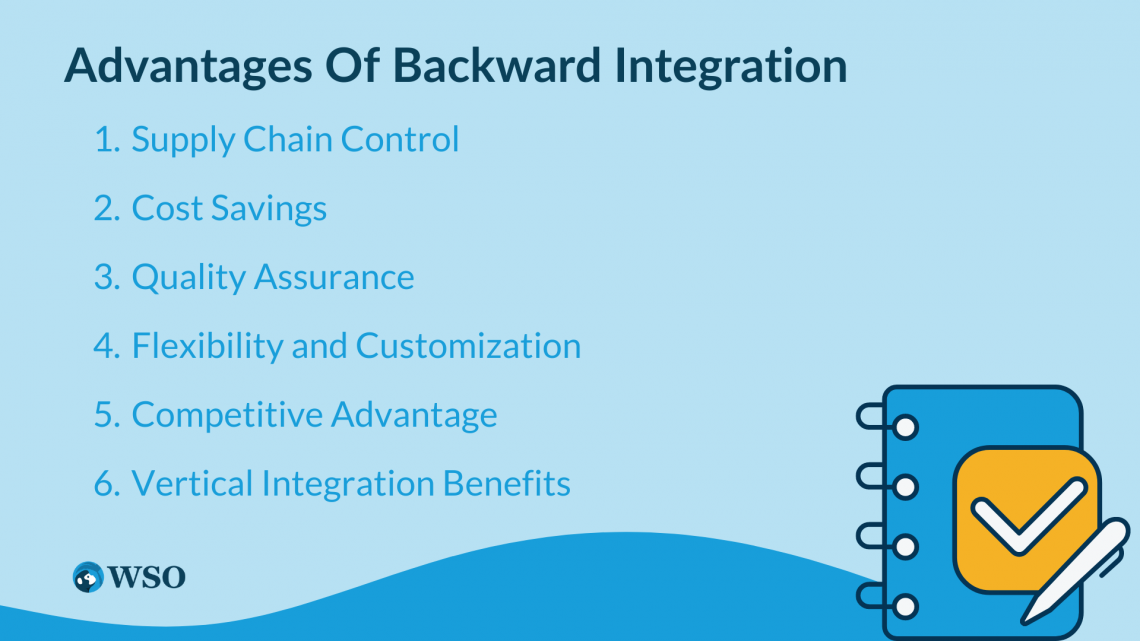
Let's explore some of the key advantages of it:
1. Supply Chain Control
It enables companies to gain direct control over the production or distribution of key inputs or components.
Organizations can eliminate supplier reliability and performance uncertainties by integrating with suppliers or producers. They can ensure consistent quality, timely delivery, and better coordination in the supply chain.
NOTE
The supply chain control leads to increased operational efficiency and reduced risks related to supply disruptions.
2. Cost Savings
By bringing previously outsourced functions in-house, companies can potentially reduce costs and eliminate markups imposed by middlemen. It eliminates the need to rely on external suppliers and their associated expenses.
Companies can streamline processes, negotiate better input pricing, and achieve cost savings through economies of scale.
NOTE
The cost advantage can ultimately improve the company's profitability and competitiveness in the market.
3. Quality Assurance
Implementing it gives companies direct oversight and control over the production process. They can enforce strict quality control measures and ensure the components or raw materials meet their desired specifications.
NOTE
By maintaining consistent quality standards, organizations can enhance customer satisfaction, build brand reputation, and gain a competitive edge in the market.
4. Flexibility and Customization
It allows companies to customize products according to their specific requirements. Organizations can make adjustments and modifications more efficiently by having control over the production process.
They can respond quickly to changing market demands, customer preferences, or technological advancements.
NOTE
The agility in customization can result in improved product offerings and increased customer loyalty.
It can help companies differentiate themselves from competitors. Organizations can create unique value propositions by integrating upstream and controlling critical inputs or components, leading to building competitive advantages.
They can offer products with distinct features, higher quality, or cost advantages that competitors may not easily replicate.
NOTE
The differentiation strengthens their market position and makes it harder for rivals to imitate their offerings.
6. Vertical Integration Benefits
They often complement existing vertical integration strategies. When a company controls both the upstream and downstream aspects of its supply chain, it can optimize coordination, enhance communication, and improve overall efficiency.
This integrated approach enables a seamless flow of information, faster decision-making, and better alignment of business objectives across the value chain.
Challenges And Risks Of Backward Integration
While it offers numerous advantages, companies must be aware of the challenges and risks of implementing this strategic approach.
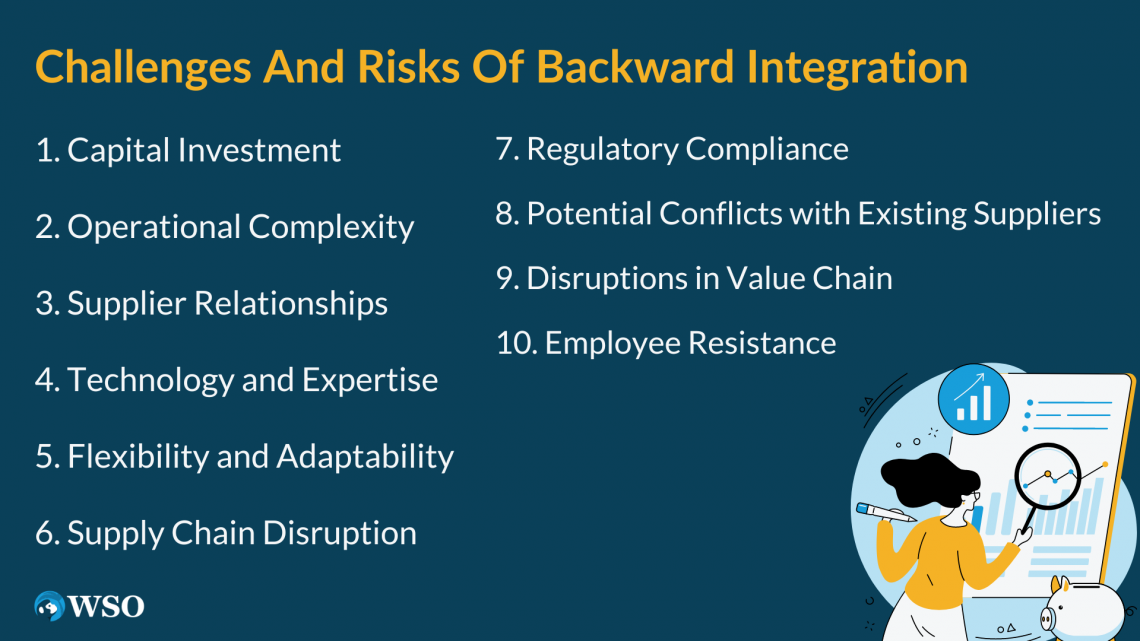
It involves significant investments, changes in business operations, and potential disruptions to the existing supply chain.
Here are some of the key challenges and risks that companies may encounter:
1. Capital Investment
Implementing it often requires substantial capital investments. Companies need to acquire or establish production facilities, machinery, and technology to carry out the newly integrated activities.
These upfront costs can pose a significant financial burden, especially for smaller organizations or those operating on tight budgets. Proper financial planning and evaluation of return on investment are crucial to mitigate this challenge.
2. Operational Complexity
This involves taking on additional responsibilities and managing new areas of the supply chain. Companies may face complexities in terms of production planning, inventory management, and quality control for integrated activities.
NOTE
Ensuring smooth operations and maintaining efficiency can be challenging, particularly if the organization lacks experience or expertise in the newly integrated functions.
3. Supplier Relationships
It may strain relationships with existing suppliers or third-party manufacturers. As a company starts producing its inputs or components, it may reduce its reliance on external suppliers.
This shift in dynamics can potentially lead to conflicts or strained partnerships. Managing these relationships and ensuring a smooth transition is crucial to minimize disruptions in the supply chain.
4. Technology and Expertise
Successfully integrating upstream requires acquiring or developing new technological capabilities and expertise. Companies must have the necessary knowledge and resources to operate in the newly integrated area effectively.
NOTE
A lack of technological infrastructure or skilled personnel can hinder the implementation of this strategy and limit the ability to achieve desired outcomes.
5. Flexibility and Adaptability
It can reduce a company's flexibility and ability to adapt to market changes. By bringing previously outsourced activities in-house, organizations may become less agile in responding to shifts in customer preferences or industry trends.
Adjustments to production processes or product offerings can become more challenging, potentially limiting the company's ability to stay competitive in dynamic markets.
6. Supply Chain Disruptions
While it aims to reduce supply chain risks, it introduces a different set of potential disruptions. Companies may encounter challenges related to production delays, quality issues, or insufficient capacity in the newly integrated activities.
NOTE
Any disruptions in the integrated functions can ripple through the entire supply chain, impacting overall operations and customer satisfaction.
7. Regulatory Compliance
Compliance with industry regulations and government policies related to the newly integrated activities can pose challenges.
Ensuring adherence to legal requirements and obtaining necessary permits or licenses is crucial to avoid penalties or legal complications.
8. Potential Conflicts with Existing Suppliers
Potential conflicts with existing suppliers can arise during backward integration as the organization reduces its reliance on external suppliers.
NOTE
The shift in dynamics can strain relationships and lead to disputes over pricing, contracts, or reduced business volumes, requiring careful management to minimize disruptions in the supply chain.
9. Disruptions in Value Chain
Implementing this strategy can disrupt the value chain by altering the flow of activities and dependencies. Integrating upstream processes may cause disruptions in the sourcing of raw materials, production schedules, and distribution channels.
Any issues or delays in the newly integrated activities can ripple through the value chain, affecting downstream operations and customer satisfaction, emphasizing the importance of seamless coordination and contingency planning.
10. Employee Resistance
Employees may resist changes associated with this integration strategy, especially if it affects their roles or job security. Managing employee concerns, providing training, and addressing any potential job displacement is important to ensure a smooth transition.
NOTE
To mitigate these challenges and risks, companies considering this strategy should conduct thorough feasibility studies, assess the potential impact on existing operations, and develop a comprehensive implementation plan.
Evaluating the financial implications, technological requirements, and potential effects on supplier relationships is crucial.
Careful planning, effective communication, and ongoing evaluation of the integrated operations are essential to navigate the challenges and realize the benefits of backward integration successfully.
Backward Integration Factors
Implementing the strategy can be a complex and transformative process for a company.
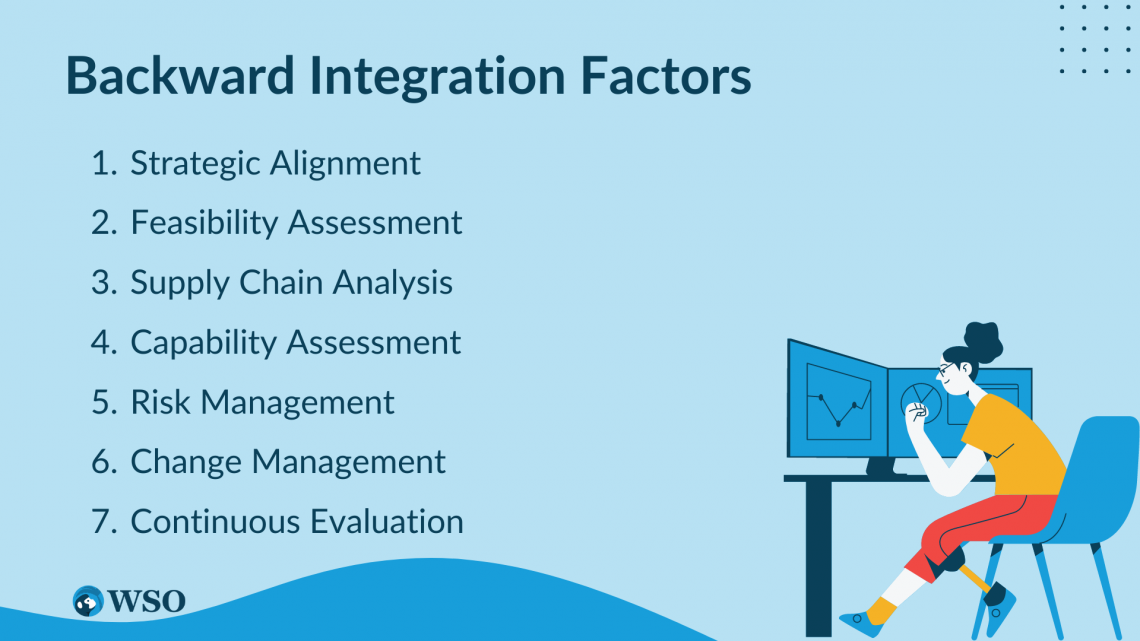
Several factors need to be carefully considered and addressed to ensure its success. By considering these factors, organizations can effectively navigate the challenges and risks associated with this strategy.
Here are some key factors to consider:
1. Strategic Alignment
It should align with the company's overall strategic goals and objectives. Evaluating how integrating upstream fits into the company's long-term vision and competitive positioning is essential.
The integration should enhance the company's core capabilities, improve its value proposition, and strengthen its market position.
2. Feasibility Assessment
Conducting a thorough feasibility study is critical before embarking on this strategy. This assessment should evaluate the financial implications, technological requirements, and potential risks associated with integrating the new activities.
NOTE
Backward integration should consider factors such as capital investment, operational complexity, resource availability, and potential impacts on existing operations.
3. Supply Chain Analysis
Analyzing the existing supply chain is crucial to identify the areas where it can add value. Understanding the current suppliers, their capabilities, and potential risks can help determine which components or inputs should be integrated.
In supply chain analysis, organizations can assess the suitability of different components or inputs for integration by considering several factors:
- Criticality
Evaluate the importance of the component or input in the overall supply chain. Identify which components are critical to the organization's operations and determine if integrating them would provide strategic advantages or reduce risks. - Availability
Assess the availability of the component or input in the market. Consider factors such as market demand, supplier capacity, and potential constraints that may affect the reliable and consistent availability of the component. - Supplier Reliability
Evaluate the reliability and performance of potential suppliers. Consider factors like their track record, reputation, financial stability, and ability to meet quality and delivery requirements. - Potential Impact on Cost Structure
Analyze the potential impacts on the organization's cost structure. Evaluate the cost savings or cost increases associated with integrating the component.
This analysis should consider factors such as supply chain efficiency, reliability, cost structure, and critical dependencies.
4. Capability Assessment
It is essential to assess the company's internal capabilities to determine if it has the necessary resources, expertise, and technology to undertake the integrated activities.
NOTE
The evaluation should identify any gaps in knowledge, skills, or infrastructure and develop plans to address them. Building or acquiring the required capabilities is essential for the success of this strategy.
5. Risk Management
Backward integration introduces new risks to the company. Identifying and managing these risks is crucial. Risks can include supply disruptions, quality control issues, supplier relationship challenges, or financial implications.
Developing risk mitigation strategies and contingency plans and establishing monitoring mechanisms are essential to minimize potential disruptions and negative impacts.
6. Change Management
Implementing the strategy requires organizational change. It is essential to effectively manage this change and gain buy-in from key stakeholders, including employees, suppliers, and customers.
NOTE
Clear communication, training programs, and support mechanisms should be established to facilitate a smooth transition and ensure that everyone understands the benefits and objectives of the integration.
7. Continuous Evaluation
Ongoing evaluation and monitoring of the backward integration process are critical to assess its effectiveness and make necessary adjustments.
Key performance indicators (KPIs) should be established to track the performance of the integrated activities, such as cost savings, quality metrics, and supply chain efficiency.
Regular reviews and assessments will help identify areas of improvement and ensure the integration aligns with the company's goals.
By considering these factors, companies can increase their chances of successful backward integration.
NOTE
Careful planning, strategic alignment, thorough analysis, and effective change management are key elements in navigating the complexities and reaping the benefits of integrating upstream in the supply chain.
Best Practices And Recommendations For Backward Integration
Implementing this strategy can bring numerous benefits to organizations, including increased control over the supply chain, cost savings, improved efficiency, and enhanced competitiveness.
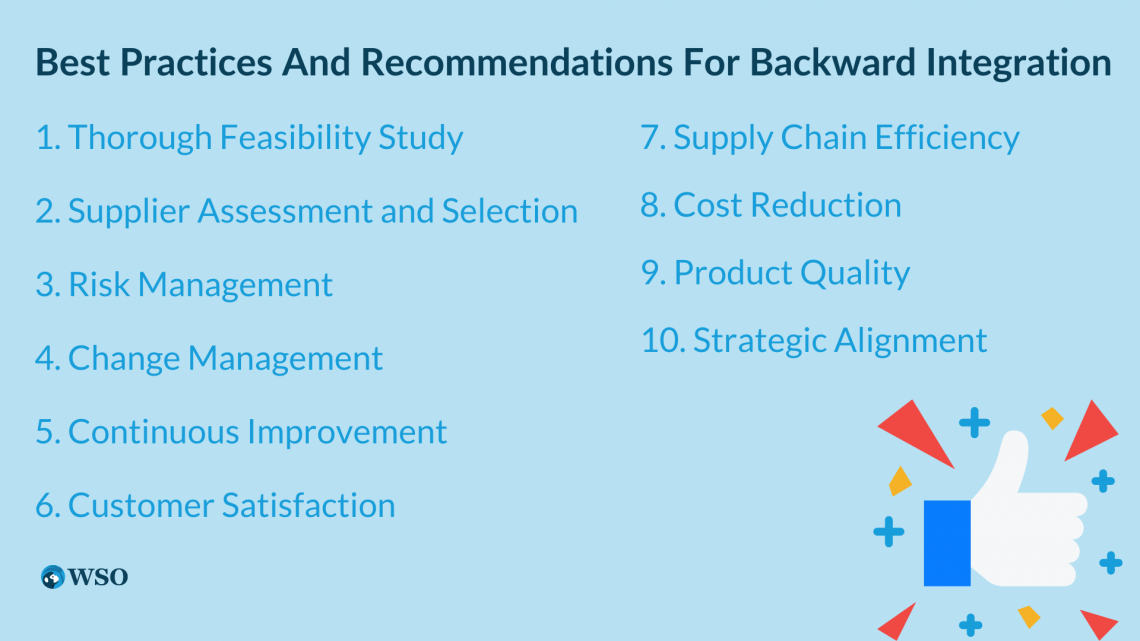
However, to ensure the successful execution of this strategic approach, organizations should follow best practices and consider key recommendations.
Additionally, defining specific metrics or key performance indicators (KPIs) enables organizations to measure the success of the strategy. Here are some best practices and recommendations, along with suggested metrics for evaluation:
1. Thorough Feasibility Study
Before embarking on it, conduct a comprehensive feasibility study. Assess the financial implications, technological requirements, and potential risks associated with integrating the new activities.
NOTE
Metrics for evaluation: Return on Investment (ROI), Net Present Value (NPV), Payback Period.
2. Supplier Assessment and Selection
Carefully evaluate and select suppliers for the integrated activities. Consider their reliability, quality standards, capacity, and cost competitiveness.
NOTE
Metrics for evaluation: Supplier Performance Scorecards, Supplier Quality Ratings, Supplier Delivery Performance.
3. Risk Management
Identify and manage risks associated with backward integration. Develop risk mitigation strategies, contingency plans, and monitoring mechanisms.
NOTE
Metrics for evaluation: Number of supply chain disruptions, Cost of quality issues, Time to recover from disruptions.
4. Change Management
Effectively manage the organizational change that comes with it. Communicate the benefits, objectives, and expectations to all stakeholders. Provide training programs and support mechanisms for employees.
NOTE
Metrics for evaluation: Employee satisfaction and engagement, Training completion rates, and Time to Adoption of new processes.
5. Continuous Improvement
Regularly evaluate and monitor the integrated activities to identify areas for improvement. Continuously optimize processes, reduce costs, and enhance performance.
NOTE
Metrics for evaluation: Cost savings achieved, Process cycle time, Productivity improvements.
6. Customer Satisfaction
Monitor customer satisfaction levels to ensure that the integration does not negatively impact product quality, delivery, or overall customer experience.
NOTE
Metrics for evaluation: Customer satisfaction surveys, Customer complaints & and returns, and On-time delivery performance.
7. Supply Chain Efficiency
Measure the efficiency of the integrated supply chain by evaluating factors such as inventory turnover, lead times, and order fulfillment.
NOTE
Metrics for evaluation: Inventory turnover ratio, Order fulfillment cycle time, Perfect order rate.
8. Cost Reduction
Assess the impact of backward integration on cost structure. Monitor cost savings achieved through reduced reliance on external suppliers and improved production efficiency.
NOTE
Metrics for evaluation: Cost of goods sold (COGS), Direct material costs, Overhead costs.
9. Product Quality
Ensure that product quality remains consistent or improves with backward integration. Monitor quality metrics to identify any deviations or issues.
NOTE
Metrics for evaluation: Defective product rate, Customer returns due to quality issues, and Quality audit results.
10. Strategic Alignment
Regularly review the strategic alignment of the integration with the company's overall goals and objectives. Evaluate the impact on the organization's market position and competitive advantage.
NOTE
Metrics for evaluation: Market share, Customer loyalty, Competitor analysis.
By following these best practices and using the suggested metrics for evaluation, organizations can effectively assess the success of their backward integration efforts.
Regular monitoring, continuous improvement, and strategic alignment are key to reaping the full benefits of this strategic approach and maintaining a competitive edge in the market.
Examples of Backward Integration
Successful backward integration can be observed across various sectors, where companies have strategically integrated upstream activities to gain more control over their supply chains, improve efficiency, and create competitive advantages.
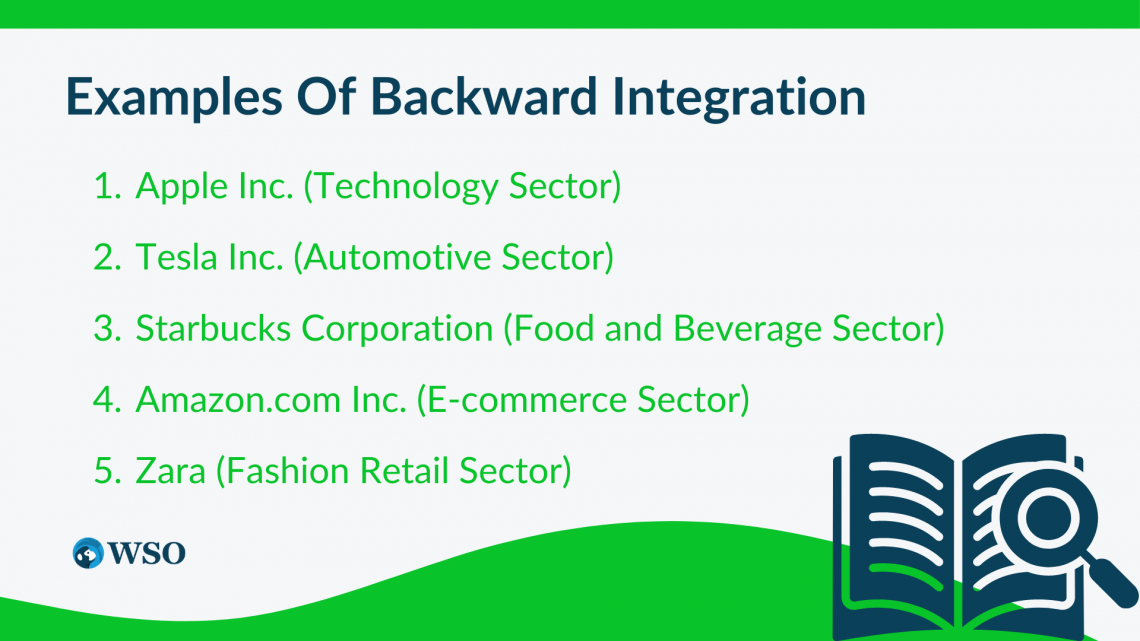
Here are a few examples of companies from different sectors that have achieved success through this integration strategy:
1. Apple Inc. (Technology Sector)
Apple, a leading technology company, successfully implemented it by acquiring semiconductor companies, such as PA Semi and AuthenTec.
This allowed Apple to gain control over critical components, including processors and biometric security technology, ensuring a consistent supply and maintaining a competitive edge in the highly competitive smartphone market.
2. Tesla Inc. (Automotive Sector)
Tesla, an innovative electric vehicle manufacturer, implemented it by acquiring SolarCity, a solar energy company.
NOTE
The integration allowed Tesla to vertically integrate renewable energy generation with its electric vehicle production, offering a completely sustainable energy solution to its customers.
3. Starbucks Corporation (Food and Beverage Sector)
Starbucks, a global coffeehouse chain, successfully backward integrated by acquiring coffee farms and roasting facilities.
This integration enabled Starbucks to have direct control over the coffee bean sourcing and roasting processes, ensuring consistent quality and sustainability practices throughout the supply chain.
4. Amazon.com Inc. (E-commerce Sector)
Amazon, a renowned e-commerce giant, implemented it by establishing its own logistics and delivery network.
By acquiring fleets of delivery vehicles, building fulfillment centers, and developing last-mile delivery capabilities, Amazon reduced its reliance on third-party logistics providers and achieved faster and more reliable deliveries for its customers.
5. Zara (Fashion Retail Sector)
Zara, a popular fashion retailer, successfully implemented backward integration by establishing in-house manufacturing facilities.
By owning and controlling the entire production process, from design to manufacturing, Zara achieved shorter lead times, faster product replenishment, and increased flexibility to respond to changing fashion trends.
NOTE
All of the examples highlight the diverse ways in which companies have leveraged backward integration to enhance their competitiveness and supply chain efficiency.
By strategically integrating upstream activities, these companies have gained more control over critical components, reduced dependency on external suppliers, improved product quality, and achieved cost savings.
It has played a pivotal role in their success and serves as inspiration for other organizations seeking to optimize their supply chains and create a competitive advantage in their respective industries.




or Want to Sign up with your social account?